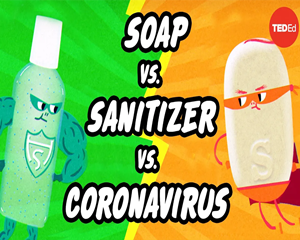Your hands, up close, are anything but smooth. With peaks and valleys, folds and rifts, there are plenty of hiding places for a virus to stick.
你的手近距离看并不光滑。手上高低交错的褶皱裂纹中,有许多能够让病毒附着的地方。
If you then touch your face, the virus can infect you.
如果此时用手触碰脸部,就有可能被手上的病毒感染。
But there are two extraordinarily simple ways you can keep that from happening: soap and water, and hand sanitizer. So which is better?
但是用两种非常简单的方法就可以避免上述情况的发生:用香皂和清水,或是免洗洗手液。那么,究竟哪一种更好呢?
The coronavirus that causes COVID-19 is one of many viruses whose protective outer surface is made of a lipid bilayer.
引起COVID-19的新型冠状病毒,其保护性的外表面由脂质双分子层构成。
These lipids are pin shaped molecules whose heads are attracted to water, and tails are repulsed by it.
这些脂质是呈大头针状的分子,头部具有亲水性,尾部具有疏水性。
So in water-rich environments, lipids naturally form a shell like this, with the heads outside and the tails inside.
因此在富含水的环境中,脂质自然地形成了一个壳,壳外侧由头部构成,内侧由尾部构成。
Their shared reaction to water makes the lipids stick loosely together -- this is called the hydrophobic effect.
头尾对水的反应让脂质分子松散地附着在一起,这就是疏水效应。
This outer structure helps the molecular machinery of the virus break through cellular membranes and hijack our cells.
这种外部结构有助于病毒分子侵入细胞膜并劫持我们的细胞。
But it has thousands upon thousands of weak points where the right molecules could pry it apart.
但是外部结构也有着成千上万的弱点,特定的分子可以将其撬开。
And this is where soap comes in. A single drop of any brand of soap contains quadrillions of molecules called amphiphiles, which resemble biological lipids.
这就是香皂的清洁原理。一小块任何品牌的香皂都包含着千万亿叫做两亲化合物的分子,类似生物脂质。
Their tails, which are similarly repulsed by water, compete for space with the lipids that make up the virus's shell.
它们疏水的尾部会与构成病毒外壳的脂质争夺空间。
But they're just different enough to break up the regularity of the virus's membrane, making the whole thing come crashing down.
尾部与病毒外壳脂质的差异足以打破病毒表面的成膜规则,导致整个膜结构的破碎。
Those amphiphiles then form bubbles of their own around particles including the virus's RNA and proteins. Apply water, and you'll wash that whole bubble away.
然后这些两亲化合物就会在病毒RNA和蛋白质周围形成泡泡,只要用水就能将这些泡泡洗掉。
Hand sanitizers work less like a crowbar, and more like an earthquake.
比起撬棍,免洗洗手液的作用更像一场地震。
When you surround a coronavirus with water, the hydrophobic effect gives the bonds within the membrane their strength.
当你用水裹住新冠病毒时,它的疏水效应会让膜内结构更坚不可摧。
That same effect also holds the big proteins that form coronavirus's spikes in place and in the shape that enables them to infect your cells.
同样的效应也可固定构成新冠病毒尖端的蛋白质,此尖端的外形让病毒得以侵入你的细胞。
If you dry the virus out in air, it keeps its stability.
如果你将病毒吹干,它依然会保持稳定状态。

But now surround it with a high concentration of an alcohol, like the ethanol or isopropanol found in most hand-sanitizers.
但是现在,我们用高浓度酒精,也就是多数免洗洗手液都含有的乙醇或异丙醇裹住它。
This makes the hydrophobic effect disappear, and gives the molecules room to move around.
这会让疏水效应消失,并提供了让分子移动的空间。
The overall effect is like removing all of the nails and mortar from a house and then hitting it with an earthquake.
酒精带来的整体效果相当于把一栋房子的所有钉子和灰泥都移除,然后用一场地震摧毁它。
The cell's membrane collapses and those spike proteins crumble.
于是病毒的膜坍塌了,突刺蛋白也随之破碎失活。
In either method, the actual process of destroying the virus happens in just a second or two.
不管用香皂还是免洗洗手液,消灭病毒的过程在一两秒内便会完成。
But doctors recommend at least 20 seconds of hand-washing because of the intricate landscape that is your hand.
但医生建议洗手的时间持续至少20秒,这是因为手上有着复杂的纹路。
Soap and sanitizer need to get everywhere, including your palms, fingertips, the outsides of your hands, and between your fingers, to protect you properly.
香皂和洗手液需要覆盖到包括手掌,指尖,手背和手指间的任何位置才能更好的保护到你。
And when it comes to a coronavirus outbreak, doctors recommend washing your hands with soap and water whenever possible.
在新冠病毒爆发的情况下,医生建议尽可能用香皂和清水去洗手。
Even though both approaches are similarly effective at killing the virus, soap and water has two benefits: first it washes away any dirt which could otherwise hide virus particles.
尽管香皂和洗手液在消毒方面一样有效,香皂和清水有着两个好处:首先,它们会洗去手上隐藏病毒分子的污垢。
But more importantly, it's simply easier to fully cover your hands with soap and water for 20 seconds.
更重要的是,在20秒钟内,它们可以轻松的覆盖到你手上的各个角落。
Of course, hand sanitizer is more convenient to use on the go.
当然,免洗洗手液使用起来更为便捷。
In the absence of a sink, use the sanitizer as thoroughly as possible and rub your hands together until they're dry.
当你不方便洗手时,可以大量涂抹免洗洗手液,并将两手充分摩擦直到液体变干。
Unfortunately, there are billions of people who don't have access to clean drinking water, which is a huge problem at any time but especially during an outbreak.
不幸的是,有数十亿人没有条件得到干净的饮用水,这在任何时候都是个大难题,尤其是病毒爆发期。
Researchers and aid groups are working to provide solutions for these communities.
研究者和援助组织都在努力为这些人群提供解决方案。
One example is a device that uses salt, water, and a car battery to make chlorinated water that kills harmful pathogens and is safe for hand-washing.
比如利用由盐、水和汽车电池组成的设备制造可消灭病菌,也可用来洗手的氯化水。
So wherever possible, soap and water are recommended for a coronavirus, but does that mean it's best for every viral outbreak?
因此,只要条件允许,最好使用香皂和清水来消灭新冠病毒,但这是否表示它们针对所有病毒都最有效呢?
Not necessarily. Many common colds are caused by rhinoviruses that have a geometric protein structure called a capsid instead of a lipid membrane.
未必。很多普通感冒是由鼻病毒引发的,它有一种称为“衣壳”的几何蛋白结构,而不是脂质膜结构。
The capsid doesn't have nearly as many weak points where soap amphiphiles can pry it apart, so it takes longer for soap to be effective.
衣壳并没有那么多能让香皂中两亲化合物撬开的破绽,因此香皂需要更长时间才能起作用。
However some of its surface proteins are still vulnerable to the destabilizing effect of hand sanitizer.
然而有些鼻病毒表面的蛋白质依然容易受到免洗洗手液的影响。
In this and similar cases, hand sanitizer may be more effective, especially if you then wash your hands to remove residual particles.
因此在类似情况下,免洗洗手液更加有效,尤其是当你随后接着用香皂洗去手上的残留物。
The best way to know which to use for any given outbreak is to do what's best for all things illness-related: follow the advice of accredited medical professionals.
对于任何流行病,想要了解如何选择最有效的清洁方式,只需要做对所有病症都有效的事:遵循医疗专业人士的建议。













